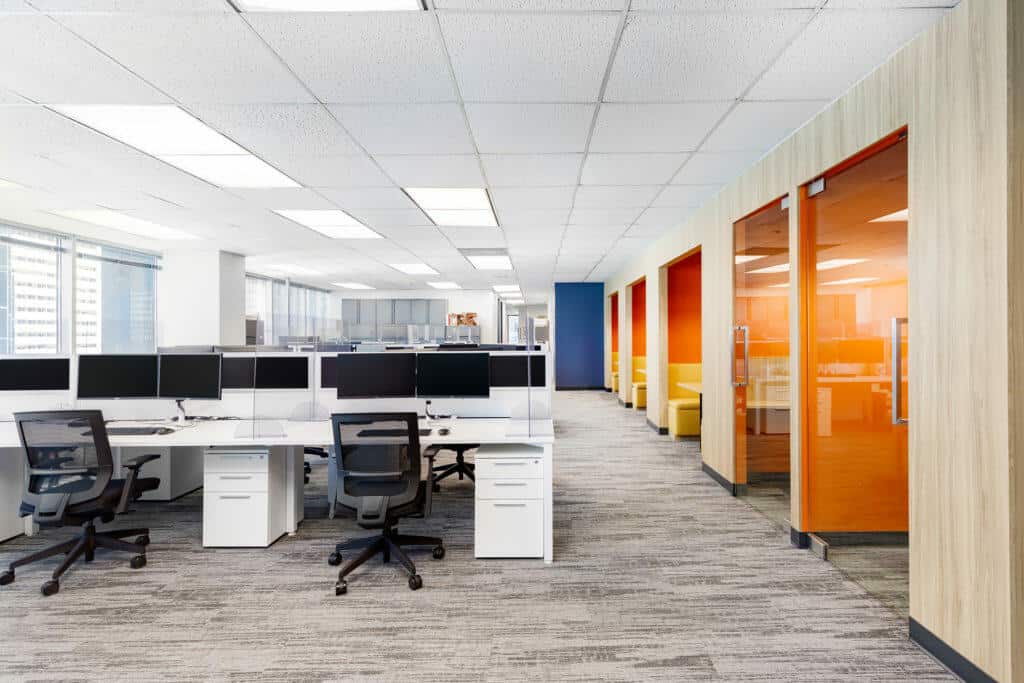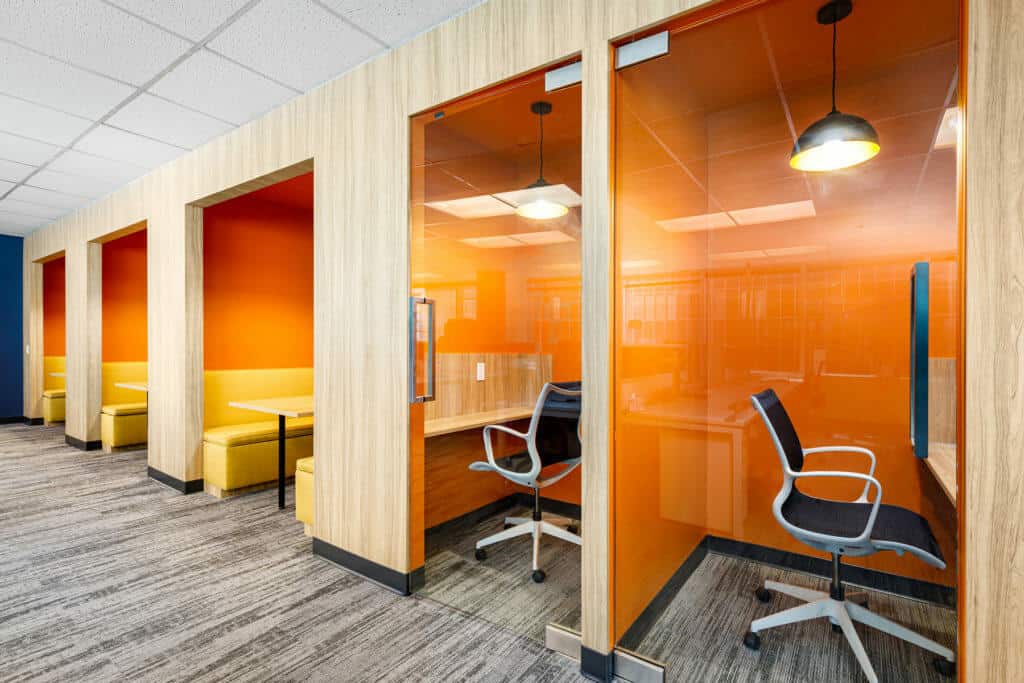In today’s ever-shifting world of work, the design of office spaces plays a crucial role in not only shaping employee productivity, well-being, and overall satisfaction, but in retaining staff and attracting the next generation of top talent.
One key aspect of office design – interestingly, sometimes overlooked – is the strategic use of color. From influencing the mood of the team to stimulating creativity, color theory offers valuable insights into how different hues can impact workplace dynamics.
In this blog, we’re going to delve into the world of color theory, exploring its origins, the pioneering work of Angela Wright, a renowned color psychologist – and take a look at an indepth 2023 study on the subject .
We’ll discuss how understanding the psychological and emotional effects of color plays a huge part in successful workplace design and helps to create environments that foster creativity, collaboration, talent retention and talent acquisition. Let’s dive in…

The Roots of Color Theory
Color theory’s roots run deep, tracing back to ancient times, and drawing contributions from various philosophy, art and science.
A more recent area of study, however, focuses on the work of color theorist Angela Wright, whose work the “Four Color Personalities” gained prominence in the late 70s and early 80s.
Her theory posits that individuals can be classified into four color categories: spring, summer, autumn, and winter, with each color group being associated with specific personality traits and emotions. For example, spring is often linked to energy, passion, and intensity, while summer is associated with calmness, trust, and logic. These color categories help identify psychological responses to different colors.
Since its publication, Wright’s insights have significantly influenced fields including interior design, marketing, branding, and fashion – but It’s worth noting that today’s researchers emphasize the need for a nuanced understanding of how color impacts individuals.
This brings us to an even more recent study on color theory.

Recent Color Theory Findings
A 2023 report by the Online Journal of Art & Design, entitled ‘A Review: The Influence of Colours in Work Environments’, reported 5 main findings, many of which echo the work of Wright. They are:
- Psychological Impact: Color significantly affects individuals’ moods and emotions, with certain colors eliciting specific responses. For example, colors such as blue and green are calming and can increase employee satisfaction and productivity.
- Physiological Effects: Color can influence physiological responses such as stress levels, heart rate, and comfort. Warm colors, including red and orange are stimulating and can increase arousal levels, while cool colors like blue and green have a relaxing effect.
- Preference and Perception: Individual color preferences and perceptions of the environment also play a role in the impact of color in the workplace. Understanding employees’ preferences and how they perceive their environment can help in selecting colors that enhance job performance.
- Behavioral Outcomes: The use of color in work environments can lead to behavioral outcomes such as increased creativity, productivity, and overall job performance. Colors can create a conducive atmosphere for collaboration, innovation, and focus, contributing to the success of the organization.
- Variable Factors: Factors such as hue, saturation, value, and different color schemes (chromatic/achromatic, warm/cool) all contribute to the overall impact of color. Additionally, individual differences, such as gender and stimulus screening ability, can influence how individuals respond to color stimuli.

How Businesses Can Leverage Color Theory: 6 Practical Steps
What is clear from these various fields of research is that color is significant in shaping human behavior and perception. And by exploring the principles of color theory, businesses can harness the potential of color to create environments conducive to success. Let’s take a look at six practical steps for using color to transform your workplace.
Harness the Power of Blue
As we’ve seen, blue is often associated with calmness, trust, and productivity, making it an excellent choice for office environments.
Incorporating shades of blue in areas where focus and concentration are essential can help create a serene atmosphere conducive to deep work.
Consider using blue in conference rooms, workstations, and areas where employees engage in tasks requiring intellectual engagement.
The right amount of blue can enhance creative task performance – but note, an overload of blue can have a drowsy effect.

Energize with Red and Orange Accents
Red is a dynamic color that stimulates energy, passion, and urgency.
While excessive use of red and orange can be overwhelming, incorporating accents of each shade can inject vitality and excitement into the workplace.
Consider using these colors in areas where physical activity or creativity is encouraged, such as break rooms, brainstorming areas (like our work for Farber Debt Solutions’ head office in the main image), or collaborative spaces.
However, bear in mind that working in an overly red or colorful room can put the brain into a more excited state – causing overstimulation and a lack of concentration.
Foster Creativity with Yellow
Yellow is associated with optimism, creativity, and innovation, making it an ideal choice for those keen to foster a positive work environment.
Incorporating touches of yellow in areas where brainstorming, ideation, or teamwork occur can stimulate creativity and encourage collaboration.
Think about using yellow in communal spaces, breakout areas, or on accent walls to infuse your space with energy and vibrancy.

Create Balance with Green
Green, first and foremost, is easy on the eyes and ideal for spaces where balance is paramount.
The shade represents balance, harmony, and tranquility, making it a versatile color for office design. It’s why we chose it for key areas of PPI Toronto’s redesigned workplace, pictured above.
Incorporating shades of green – and other earthy tones, including beiges, browns and creams – in workspaces can evoke feelings of calmness and well-being, promoting focus and productivity.
Use it in areas where employees need to recharge and relax, such as quiet zones, meditation rooms, or indoor gardens, too. By bringing elements of nature indoors, green – and its nearby natural shades – foster a connection to the environment which can enhance employee satisfaction.
Evoke Sophistication with Purple
Purple is associated with luxury and creativity, making it a sophisticated choice for office design. While too much purple can be overwhelming, incorporating subtle hints of it in decor or furnishings can give a space real impact. Consider using purple in reception areas, executive offices, or in decorative accents to create a sense of prestige and authority.
Maintain Neutrality with Greys, Whites, and Black accents
When used cleverly, grey provide a clean, minimalist backdrop that allows other colors to shine. Use shades of grey on walls, flooring, or furniture to create a sleek, cohesive look that complements other design elements.
Be mindful too that overuse of grey can have the opposite effect, evoking a lack of confidence and a certain drabness.
White symbolizes purity and cleanliness, and will provide a crisp finish to kitchen and breakout areas, while black exudes authority but can absorb natural light.
Use black sparingly, however, and it will add contrast and elegance to your workplace. See our work for Metroview Development’s workplace, below.

Color in Conclusion
By incorporating the principles of color theory into workplace design, businesses can create environments that promote productivity, creativity, and employee well-being – and which, crucially, will appeal to new talent.
Whether harnessing the calming effects of blue, energizing with red or orange accents, or encouraging creativity with yellow, the strategic use of color can make a workplace sing.
Experiment with different color palettes and combinations to find the perfect balance that suits your company culture and brand. Alternatively, if you’d like to talk it all through with a workplace design expert, give one of our team a call today.
